Internet Statistics and Trends to Watch
Table of Contents
Understanding the internet and its current trends is vital to making the most of your opportunities, especially with the rise of remote work and online education. You can see your doctor online and make new social connections, which is especially important if you live in a remote area.
Here are the most important internet statistics and trends to watch right now.
Number of Users and Increased Access
The internet adoption rate is rising rapidly among people worldwide. Increasing prosperity in many developing nations means that people can afford phones and other devices that provide internet access. Infrastructure is expanding more rapidly and efficiently than ever before. As more people get online, the world becomes ever more connected, and we become ever more reliant on the internet in daily life.
Here are some trends and statistics you should know about internet access:
- According to Internet World Stats, 4.57 billion are using the internet. That number will still grow, even as a percentage of the total population.
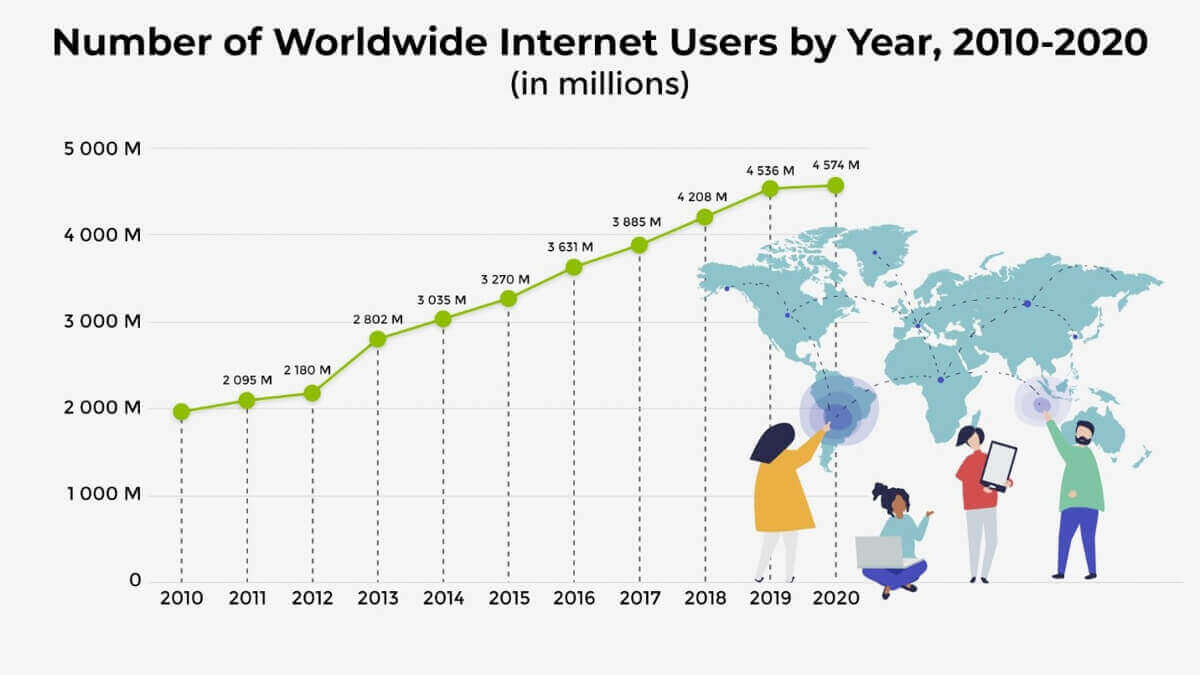
- The rapid pace of internet adoption will slow as all those who are capable of gaining access do so, and only the poorest and most isolated people are left out. Still, there is also hope that new markets will invest in infrastructure to get even more people online.
- One technology to keep on your radar is improved satellite internet. Several companies are investing in new technology, trying to be first past the starting line given the potential returns.
- ISPs or other businesses may pair up with governments and set up internet infrastructure to gain access to a new market. Federal programs in the USA are already creating this kind of partnership.
- The other major factor to consider is rate of user penetration. User penetration means the percentage of people who live in a country and are using internet service.
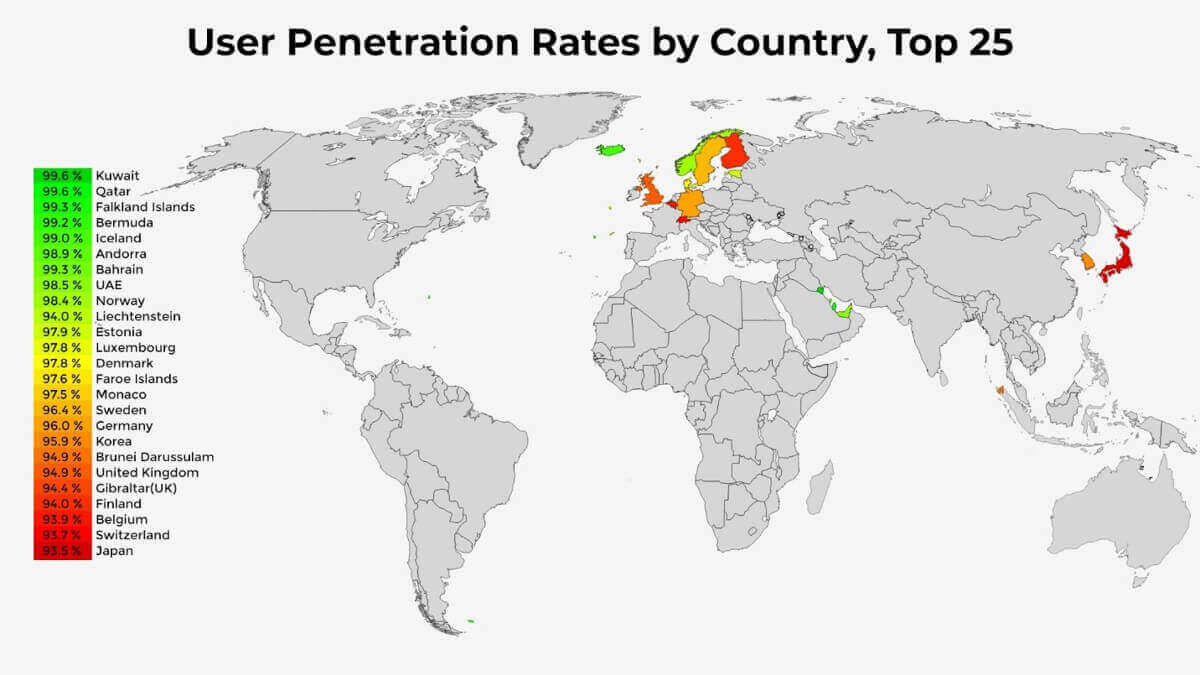
-
- Note that the United States doesn’t have one of the highest penetration rates in the world.
- Smaller, denser countries have a higher penetration rate due to the relative ease of installing infrastructure country-wide.
- It’s noteworthy that only 7 percent of the world’s population has internet access. In the next few years, we’ll get a better picture of how soon that number may grow to nearly everyone on earth.
Usage Behaviors and Trends
The average person in 2020 uses the internet for six hours and 30 minutes each day. That is more time than most people spend eating and equals the time many spend working.
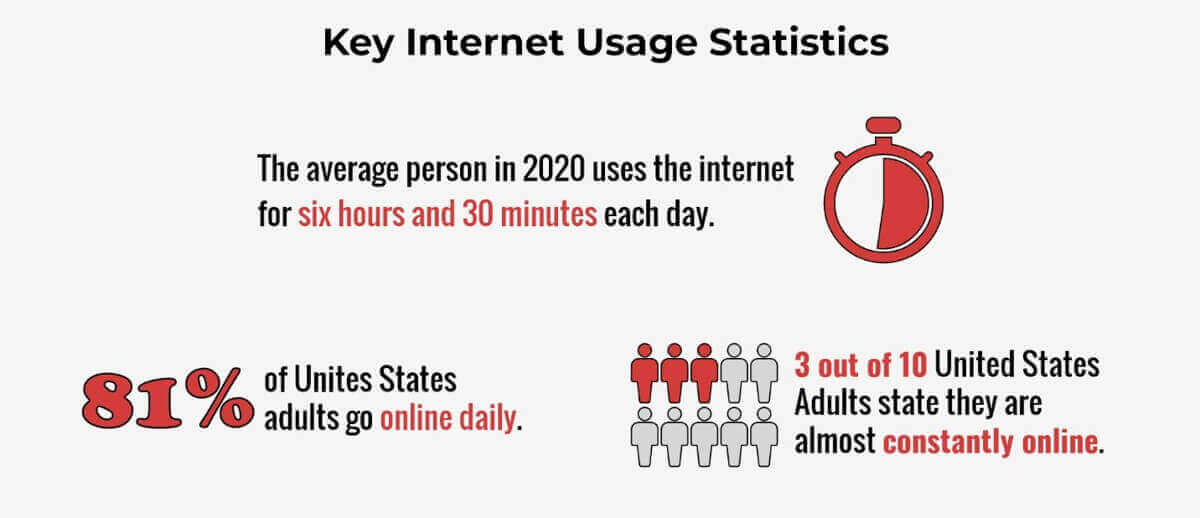
-
- Health experts have concerns about both the physical and mental health effects of this amount of usage. Still, it’s unlikely people will change their habits for any but the most harrowing findings.
- According to Pew Research, about 81 percent of United States adults go online daily. For a majority, the internet is now a part of their daily lifestyle.
- According to Internet Live Stats, there are 81,827 Google searches every second as of the time of this writing. That adds up to billions of searches made every day. People have become reliant on Google and other search engines as necessary tools to navigate daily life and work.
These stats generally include time spent on smartphones. So if you consider your own habits and find you barely spend any time on your desktop or laptop computer, you may be logging your internet hours on your phone.
Social Media
Social media has become a pillar of modern culture, responsible for the proliferation of large amounts of information and jobs for many online marketers. Here are a few statistics for you to get the pulse on social media in 2023:
- Facebook hosts a massive number of advertisements and brand promotions. According to the Sprout Social Index, 89 percent of marketers use Facebook, and 83 percent of their survey participants say they use it, despite some of the backlash the company has received in recent years.
- Users are becoming increasingly aware of marketing efforts and are more likely to ignore them. Brands have seen a median engagement rate of 09 percent among their posts.
- Users still do follow brands on Facebook. The Sprout Social Index also noted that 66 percent of survey participants followed or liked a brand on the platform.
- Younger generations are more likely to use social media, though all generations are represented.

- Most people are spending a lot of time on social media, but some make efforts to cut back. About 39 percent of the United States and United Kingdom social media users decreased their time on social media platforms over the last 12 months.
- Most of these people aren’t deleting or deactivating their accounts, but instead just trying to reduce the time they spend on those networks.
- Social media has become vital to ecommerce and the economy at large, as 54 percent of social media browsers use social media to research and better understand products.
Social media is still growing and adapting as new networks innovate and compete with the major players.
Websites and Services
The internet is an endless hive of websites and apps. Only a few gain enough buzz to attract a mainstream audience.
The total number of websites in operation is staggering. You may have noticed that there are usually thousands of search results for every query.

-
- The number of websites shown above also takes into account all the websites that expire, are deleted or are otherwise no longer online. The number of websites generally still keeps increasing despite many sites disappearing each day.
- There are also indexed and unindexed pages. Based entirely on Google’s index, there are currently about 5 billion webpages you can visit.
- If you were to look at one page every second, it would take you nearly 1900 years to view them all.
- There are several ways you can look at or measure the top websites in operation today. The clearest trend is that the top websites are household names such as Google or Facebook. It would take a great deal to unseat these names in 2023 or beyond.
- Wikipedia remains an everlasting source of information, and many of the top sites around the world are merely different language versions of the user-edited encyclopedia.
Video Streaming and Online Gaming
You may use video streaming sites nearly every day, sometimes without even thinking about it. Online gaming has become as popular as watching television among specific demographics. As these activities take on more importance in every life, the sites that host them become more powerful.
- YouTube, owned and operated by Google, is one of the undisputed largest and most important sites online. Here are a few stats to express this:
- About 2 billion people every month are logged into YouTube, and people without accounts boost that number even higher.
- Despite the small screens, 70 percent of YouTube views are on a mobile device.
- YouTube is expensive to run, but the platform also will be expected to make about 5.5 billion in ad revenue in 2023.
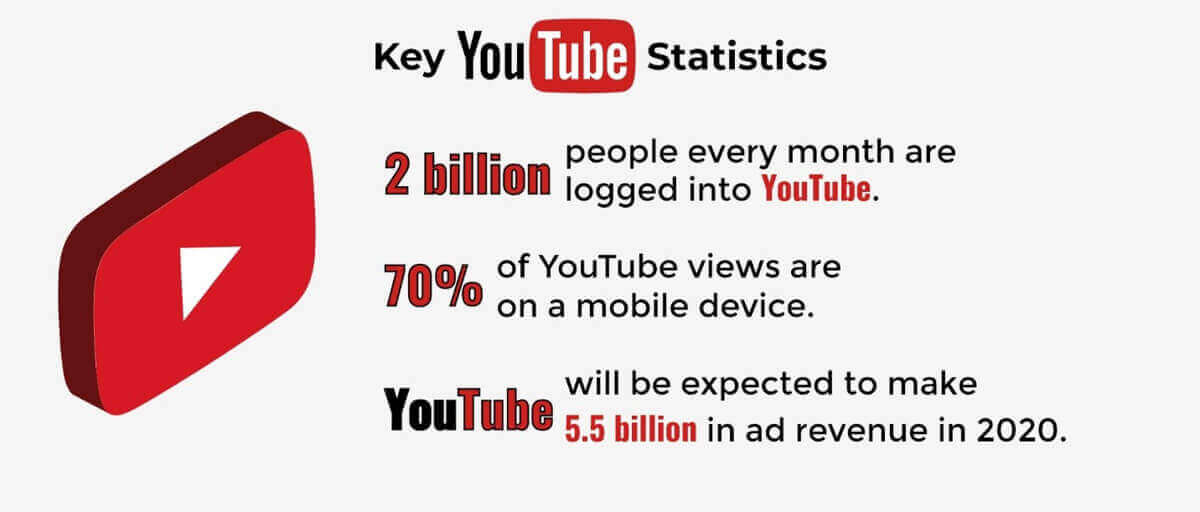
In the first quarter of 2023, streaming services were more popular than ever:
- Netflix had over 232 million subscribers.
- Prime Video had over 200 million subscribers.
- Disney had 157.8 million subscribers.
- HBO Max had over 82 million subscribers.
The COVID-19 outbreak seemed to spark even more online gaming, as people searched for safe entertainment.
- Gaming revenues surpassed those of Hollywood and any other popular entertainment industry, as gaming revenues hit $165.9 billion in 2020.
- Xbox Network users soared from 65 million in 2019 to over 120 million at the end of 2022.
- Mobile games alone will account for more than half of gaming revenue in 2020.
Smartphones and the Internet of Things
To many people, their smartphone is more important than their home computer, laptop, and nearly any other possession, given the amount of information they keep on it.
- There are 5 billion mobile internet or smartphone users worldwide.
- One development to follow in the realm of smartphone technology is the rollout of 5G networks. As programs expand, we can expect the numbers to echo 4G and 3G networks’ rollout beforehand.
- As we have increased the use of 5G networks, other areas will continue to adopt 4G and 3G technology. This change will give millions of people access to mobile data speeds that allow them to stream high-quality videos, download larger files, or perform complex tasks.
The number of internet-connected devices is exploding, as is the number of apps allowing people with smartphones to control those devices. These devices are often called the Internet of Things (IoT), and include home thermostats, security systems, lighting and stereo sound systems.
- The total number of connected devices is staggering. It is expected that the number of devices will reach 25 billion by 2021.
- Medical devices (pacemakers, etc.) now connect to the internet. Tech innovations use the internet to provide live data to medical professionals in new ways. The health care IoT market is expected to reach $140 billion by 2024. Given the enhanced need for telemedicine in 2020, some timelines on IoT devices and growth may be accelerated.
- Many vehicles connect readily to the internet, with that number increasing as more new cars hit the road. The number of connected cars was 33 million in 2017 and will reach about 77 million by 2025.
Money, eCommerce, and the Digital Economy
The digital economy is bigger and more vital than ever, driven by mobile technology and new services.
- The eCommerce market is now worth trillions of dollars, and by 2021 sales are expected to reach 4.5 trillion dollars.
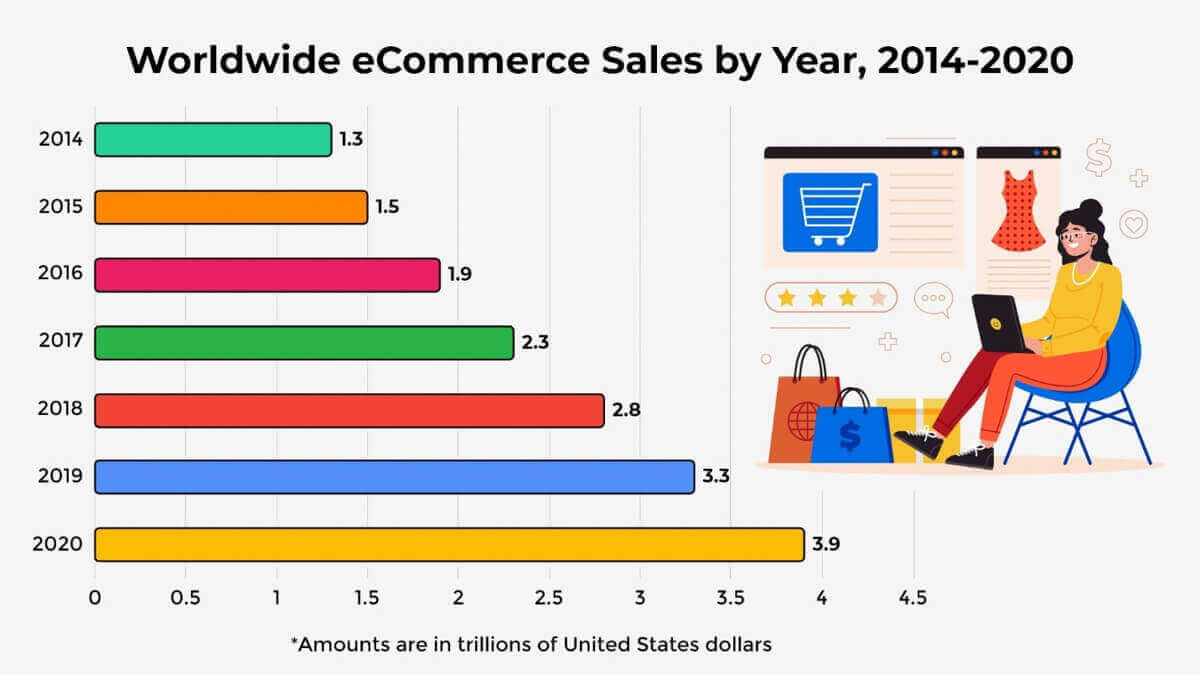
- Online shopping cart abandonment is rampant. Three out of four carts online get abandoned, with businesses in all types of sectors working to figure out how to increase conversion rates.
- Amazon is a dominant force in eCommerce. About 59 percent of millennials will first go to Amazon when looking for a product.
- According to Nielsen, online shopping is a force for globalization, with 57 percent of internet shoppers having bought a product from overseas.
And as we see increased demand for online shopping, there will be even more growth.
Conclusion
Our economies are ever more embedded in the digital world. Understanding our current internet statistics and trends allows us to try to guide our digital future. There is no doubt that the internet has brought both great benefits and real problems, across the globe. A snapshot of what seems to be happening can help us maximize those positive outcomes, and head off the ominous signs of trouble. In particular, as we maneuver through 2023, our global economy faces new challenges with the breakout success of AI. Next year, we’ll bring you a report on the effects of AI to update these findings.

